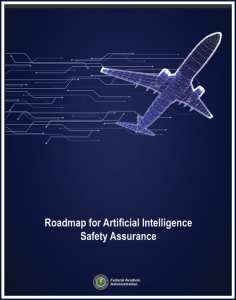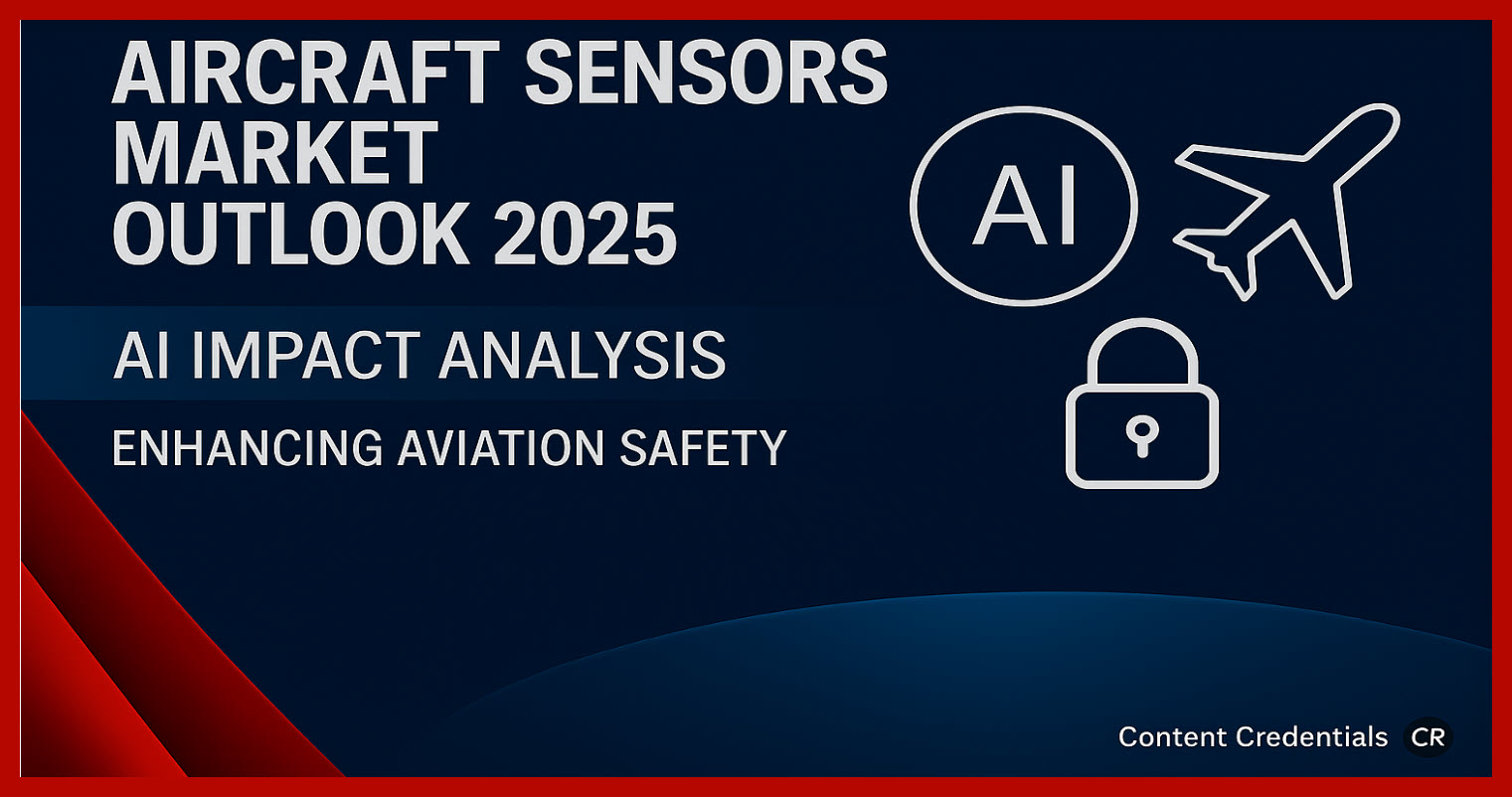Incredible Range of Sensors offer Safety Pluses while testing FAA risk adversity

A comprehensive review of the development of new SAFETY sensors and AI integration of those data is the inspiration for this post. The author covers these advancements in reducing aviation risks:
- Sensor Fault Detection and Recovery with AI
- AI in Environmental and Weather Sensors
- AI for Enhanced Situational Awareness Sensors
- Autonomous Aircraft and AI Sensor Synergy
- AI-Driven Sensor Calibration and Testing
- Cybersecurity for AI-Powered Sensor Systems
Each technology’s use is explained beginning with what is being sensed and how the information contributes to the airline’s/cockpit crew’s knowledge of what’s happening with potential impact on flight. As the list of six areas of innovation indicates, the range of positive contribution is impressive. AI and machine learning pose great improvements, but these nascent technologies are not yet known to reach the reliability which aviation demands.
The good news is that the current Administration is most welcome to these enhancements of aviation safety. Here are some of their statements:
- President Trump, in a January 2025 memorandum, urged the DoT/FAA to elevate safety and competence across the FAA
- S. Transportation Secretary Sean P. Duffy has made expediting FAA safety upgrades a CENTRAL PRIORITY in 2025, driven by a series of high-profile aviation incidents and longstanding infrastructure concerns. His approach combines aggressive modernization, workforce expansion, and regulatory reform
- Senate Testimony by Acting Administrator Rocheleau (March 27, 2025)
“Aviation safety is the FAA’s number one priority. While flying remains the safest mode of transportation, aviation safety is not static. There is always room for improvement.”
- Rocheleau emphasized:
- The need to identify trends using data analytics and machine learning
- FAA Administrator Bryan Bedford has made expediting FAA certification for safety enhancements a central theme of his leadership, emphasizing the need to overcome bureaucratic inertia and modernize regulatory processes to match the pace of technological innovation.
- Breaking Risk-Averse Culture “We must dismantle the culture of risk aversion that slows down innovation and safety improvements.”
— Bedford, as cited in VisaVerge’s aviation analysis - Bedford believes the FAA’s traditional caution has led to delays in certifying new safety technologies, such as:
- Enhanced cockpit alerting systems
- AI-assisted maintenance diagnostics
- Satellite-based navigation upgrades
- Streamlining Certification Pipelines
- Parallel testing and certification for proven technologies
- Public-private partnerships to validate safety tools faster
- Digital certification platforms to reduce paperwork and manual review cycle
- FAA Acting Administrator Christopher Rocheleau –
- AI & Data-Driven Safety:
Rocheleau emphasized using machine learning and language modeling to:
- Breaking Risk-Averse Culture “We must dismantle the culture of risk aversion that slows down innovation and safety improvements.”
-
-
- Scan incident reports.
- Identify safety trends.
- Mitigate risks involving helicopter and fixed-wing aircraft interactions.
-
Research (AI) identified the following as likely candidates for immediate attention:
- Aircraft Health Monitoring Systems (AHMS)
- Uses machine learning and real-time data analysis to monitor:
- Engine vibration
- Oil pressure
- Hydraulic systems
- Structural integrity
- Sensors like accelerometers, thermocouples, and strain gauges feed data into predictive models.
- Enables early detection of anomalies and proactive maintenance decisions.
- AI for Safety Assurance
- FAA’s roadmap distinguishes between:
- Learned AI: Static models trained offline.
- Learning AI: Dynamic systems that adapt in real time.
- Safety assurance methods are being developed for both types, with a focus on:
- Risk-managed deployment
- Clear responsibility assignments
- Avoiding personification of AI systems.
- AI-Driven Incident Analysis
- FAA is using natural language processing (NLP) and machine learning to:
- Scan safety reports
- Identify patterns in near-misses and runway incursions
- Recommend corrective actions.
The FAA Roadmap for AI Safety Assurance, takes these broad directives and provides more specific guidance
| Focus Area | Description |
| Safety Assurance | Develop methods to certify AI systems for aircraft and operations |
| Incremental Deployment | Start with low-risk applications and scale based on real-world experience |
| Workforce Readiness | Train FAA personnel to oversee AI systems and interpret outputs |
| Industry Collaboration | Align with global standards and regulators for harmonized implementation |
| Ethical Considerations | Ensure transparency, accountability, and non-personification of AI tools |
These are tremendously encouraging words. It is well known that the FAA Airworthiness professionals are risk adverse and such an approach is clearly justified. It would be advisable to enlist help in dealing the certification offices. Trust may between the consultant and the career FAA will increase the likelihood that they will positively apply those directions. Skills gained from years of experience in TC/PC/STC/PMA TSOA/CRAD projects might help; for such help CONTACT.
The aviation industry is undergoing a transformative phase, with Artificial Intelligence (AI) playing a pivotal role in redefining the design, functionality, and maintenance of aircraft sensors. These SENSORS are critical for monitoring various parameters such as SPEED, ALTITUDE, PRESSURE, AND ENVIRONMENTAL CONDITIONS, ensuring the SAFETY AND EFFICIENCY OF FLIGHT operations. The integration of AI technologies is enhancing sensor capabilities, enabling real-time data analysis, predictive maintenance, and improved decision-making processes.
AI-Enhanced Sensor Data Fusion in Aircraft
AI is revolutionizing how data from multiple sensors are combined and interpreted. Sensor data fusion involves integrating information from various sensors to produce more accurate, comprehensive, and reliable data. AI ALGORITHMS can process vast amounts of sensor data in real-time, identifying patterns and correlations that might be missed by traditional methods. This leads to improved situational awareness, more accurate navigation, and enhanced safety measures. For instance, AI can fuse data from radar, GPS, and inertial sensors to provide precise positioning information, even in challenging environments.
Predictive Maintenance Using Sensor AI
Maintenance is a significant aspect of aviation operations, with unplanned downtimes leading to substantial costs and safety risks. AI-driven predictive maintenance leverages sensor data to forecast potential failures before they occur. By analyzing trends and anomalies in sensor readings, AI systems can predict when a component is likely to fail, allowing for timely maintenance and replacements. This proactive approach not only enhances safety but also reduces maintenance costs and improves aircraft availability. For example, AI can monitor engine vibration patterns to detect early signs of wear, enabling interventions before a critical failure occurs.
AI Integration in Smart Flight Control Sensors
Flight control systems rely heavily on sensors to provide real-time data about the aircraft’s status and environment. AI integration into these sensors enhances their responsiveness and accuracy. Smart sensors equipped with AI can adapt to changing flight conditions, calibrate themselves, and provide more precise data. This leads to improved flight stability, better handling of turbulence, and enhanced autopilot performance. Moreover, AI can assist in optimizing control surfaces’ movements, resulting in smoother flights and increased fuel efficiency.
Sensor Fault Detection and Recovery with AI
SENSOR FAILURES CAN COMPROMISE FLIGHT SAFETY, making fault detection and recovery crucial. AI algorithms excel at identifying sensor anomalies by continuously monitoring data streams for inconsistencies or deviations from expected patterns. When a fault is detected, AI systems can initiate corrective actions, such as switching to backup sensors or recalibrating affected systems. This rapid response minimizes the impact of sensor failures and maintains the integrity of flight operations. Additionally, AI can learn from past faults to improve future detection and response strategies.
AI in Environmental and Weather Sensors
Weather conditions significantly influence flight safety and efficiency. AI enhances environmental and weather sensors by enabling more accurate and timely data analysis. AI models can PREDICT WEATHER PATTERNS, DETECT TURBULENCE, AND IDENTIFY POTENTIAL HAZARDS LIKE WIND SHEAR OR ICING CONDITIONS. This information allows pilots and flight planners to make informed decisions, such as altering flight paths or adjusting altitudes to avoid adverse conditions. Furthermore, AI can integrate data from various sources, including satellite imagery and ground-based sensors, to provide a comprehensive weather overview.
AI for Enhanced Situational Awareness Sensors
Situational awareness is vital for pilots to make informed decisions during flight. AI-powered sensors contribute to enhanced situational awareness by providing real-time information about the aircraft’s surroundings. These sensors can detect obstacles, monitor air traffic, and assess terrain features. AI algorithms process this data to generate alerts and recommendations, assisting pilots in navigating complex environments safely. For instance, AI can analyze sensor inputs to warn of potential collisions or deviations from the intended flight path.
Autonomous Aircraft and AI Sensor Synergy
The development of autonomous aircraft relies heavily on advanced sensor systems integrated with AI. These sensors provide critical data for NAVIGATION, OBSTACLE DETECTION, AND SYSTEM MONITORING. AI processes this data to make real-time decisions, enabling autonomous operations such as takeoff, landing, and route adjustments. The synergy between AI and sensors is essential for achieving reliable and safe autonomous flight. Moreover, AI can facilitate swarm intelligence in unmanned aerial vehicles (UAVs), allowing coordinated movements and collaborative tasks.
AI-Driven Sensor Calibration and Testing
Sensor accuracy is paramount in aviation, necessitating regular calibration and testing. AI streamlines these processes by automating calibration procedures and identifying discrepancies in sensor outputs. MACHINE LEARNING ALGORITHMS can analyze historical calibration data to predict optimal calibration intervals and detect sensors that are drifting out of specification. This proactive approach ensures sensors maintain their accuracy, reducing the risk of erroneous readings during flight. Additionally, AI can simulate various operating conditions to test sensor performance, enhancing reliability.
Cybersecurity for AI-Powered Sensor Systems
As aircraft systems become more interconnected and reliant on AI, cybersecurity becomes a critical concern. AI-powered sensors are potential targets for cyber threats, which can compromise data integrity and system functionality. Implementing robust cybersecurity measures, INCLUDING AI-BASED INTRUSION DETECTION SYSTEMS, is essential to protect sensor networks. These systems can monitor for unusual activities, detect potential breaches, and respond to threats in real-time. Ensuring the security of AI-integrated sensors safeguards the overall safety and reliability of aviation operations.
Market Trends and Future Outlook
The integration of AI into aircraft sensors is driving significant market growth and innovation. There is an increasing demand for smart sensors capable of real-time data processing and decision-making. Advancements in AI technology are leading to the development of more sophisticated sensor systems, offering enhanced capabilities and improved performance. The market is also witnessing a trend towards miniaturization and increased sensor integration, enabling more comprehensive monitoring within limited spaces. As regulatory frameworks evolve to accommodate AI technologies, the adoption of AI-powered sensors in aviation is expected to accelerate, shaping the future of the industry.
Artificial Intelligence is revolutionizing the aircraft sensor market, offering transformative benefits across design, functionality, maintenance, and safety. By enhancing data fusion, enabling predictive maintenance, improving situational awareness, and bolstering cybersecurity, AI is setting new standards in aviation operations. As technology continues to advance, the synergy between AI and aircraft sensors will play a pivotal role in shaping a safer, more efficient, and innovative aviation landscape.
Aircraft Sensors Market by Sensor Type (Pressure, Proximity, Optical, Force, Radar, Temperature, Motion), Application (Propulsion, Aerostructures & Flight Control, Flight Deck), Connectivity, End Use, Aircraft Type and Region – Global Forecast to 2030




